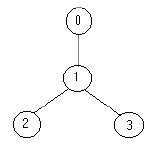Problem Description
Bob enjoys playing computer games, especially strategic games, but sometimes he cannot find the solution fast enough and then he is very sad. Now he has the following problem. He must defend a medieval city, the roads of which form a tree. He has to put the minimum number of soldiers on the nodes so that they can observe all the edges. Can you help him?
Your program should find the minimum number of soldiers that Bob has to put for a given tree.
The input file contains several data sets in text format. Each data set represents a tree with the following description:
the number of nodes
the description of each node in the following format
node_identifier:(number_of_roads) node_identifier1 node_identifier2 ... node_identifier
or
node_identifier:(0)
The node identifiers are integer numbers between 0 and n-1, for n nodes (0 < n <= 1500). Every edge appears only once in the input data.
For example for the tree:

the solution is one soldier ( at the node 1).
The output should be printed on the standard output. For each given input data set, print one integer number in a single line that gives the result (the minimum number of soldiers). An example is given in the following table:
Your program should find the minimum number of soldiers that Bob has to put for a given tree.
The input file contains several data sets in text format. Each data set represents a tree with the following description:
the number of nodes
the description of each node in the following format
node_identifier:(number_of_roads) node_identifier1 node_identifier2 ... node_identifier
or
node_identifier:(0)
The node identifiers are integer numbers between 0 and n-1, for n nodes (0 < n <= 1500). Every edge appears only once in the input data.
For example for the tree:

the solution is one soldier ( at the node 1).
The output should be printed on the standard output. For each given input data set, print one integer number in a single line that gives the result (the minimum number of soldiers). An example is given in the following table:
Sample Input
4
0:(1) 1
1:(2) 2 3
2:(0)
3:(0)
5
3:(3) 1 4 2
1:(1) 0
2:(0)
0:(0)
4:(0)
Sample Output
1
2
1 #include<cstdio> 2 #include<cstring> 3 #include<algorithm> 4 using namespace std; 5 const int maxn=1510; 6 bool father[maxn];//父节点,判断一个子节点有没有父节点 7 int brother[maxn];//兄弟节点,存入一个父节点下的多个节点 8 int son[maxn];//存入子节点 9 int dp[maxn][2];//dp,在这个节点选择放还是不放 10 int n,m,res,root; 11 12 void tree(int r){ 13 dp[r][0]=0;//该节点不放哨兵 14 dp[r][1]=1;//该节点放哨兵 15 int x=son[r];//x为该节点最后标记的子节点 16 while(x!=-1){ //只要还有子节点,继续 17 tree(x);//纵向遍历该节点 18 dp[r][1]+=min(dp[x][0],dp[x][1]);//父节点放了,子节点可以选择放与不放 19 dp[r][0]+=dp[x][1];//父节点不放,子节点要放 20 x=brother[x];//横向遍历上一个兄弟节点 21 } 22 } 23 24 int main(){ 25 while(scanf("%d",&n)!=EOF){ 26 int p,q; 27 memset(son,-1,sizeof(son)); 28 memset(father,0,sizeof(father)); 29 for(int i=1;i<=n;i++){ 30 scanf("%d:(%d)",&p,&m); 31 for(int i=1;i<=m;i++){ 32 scanf("%d",&q); 33 brother[q]=son[p];//同一个父节点的上一个兄弟 34 son[p]=q;//p的子节点是q,同时,如果m>1,输入的下一个q2的brother[q2]=q,实现之间的连接 35 father[q]=1;//标记q有父节点 36 } 37 } 38 for(int i=0;i<n;i++){ 39 if(!father[i]){//如果i没有父节点,那i就是根节点 40 root=i;//标记i为根节点 41 break; 42 } 43 } 44 tree(root); 45 res=min(dp[root][1],dp[root][0]); 46 printf("%d ",res); 47 } 48 return 0; 49 }